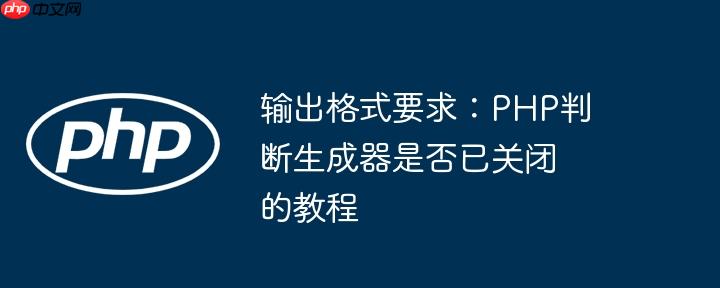Symfony 5.3 认证错误消息定制指南(定制.错误.消息.认证.指南...)

在 symfony 5.3 中,认证流程的错误处理是一个多阶段过程。许多开发者在尝试定制认证失败消息时,可能会错误地认为直接在 abstractloginformauthenticator 的 onauthenticationfailure 方法中抛出自定义异常即可。然而,这种做法通常无法奏效,原因在于 onauthenticationfailure 方法本身是被调用来处理已经发生的认证异常,而不是主动抛出异常以供后续捕获。
当用户提交登录凭据后,Symfony 的 AuthenticatorManager 会执行 authenticate() 方法。如果在此过程中发生任何认证错误(例如用户名不存在、密码错误、账户被禁用等),authenticate() 方法会抛出一个 AuthenticationException 异常。随后,AuthenticatorManager 会捕获这个异常,并调用当前 Authenticator 的 onAuthenticationFailure() 方法来处理它。
默认情况下,AbstractLoginFormAuthenticator 的 onAuthenticationFailure() 方法会将接收到的 AuthenticationException 对象存储到会话中,键名为 Security::AUTHENTICATION_ERROR。
// AbstractLoginFormAuthenticator::onAuthenticationFailure() 默认逻辑
public function onAuthenticationFailure(Request $request, AuthenticationException $exception): Response
{
if ($request->hasSession()) {
$request->getSession()->set(Security::AUTHENTICATION_ERROR, $exception);
}
$url = $this->getLoginUrl($request);
return new RedirectResponse($url);
} 在控制器中,AuthenticationUtils 服务通过调用 getLastAuthenticationError() 方法从会话中检索这个异常对象。
// SecurityController::login() 示例
public function login(AuthenticationUtils $authenticationUtils): Response
{
$error = $authenticationUtils->getLastAuthenticationError();
// ... 将 $error 传递给 Twig 模板
} 因此,如果直接在 onAuthenticationFailure 中抛出新的 CustomUserMessageAuthenticationException,这个新抛出的异常并不会被存储到会话中,而是会被 Symfony 框架更上层的异常处理器捕获,导致登录页仍然显示旧的或通用的错误消息,或者出现意外的错误页面。
要实现自定义错误消息,关键在于在认证流程中抛出能够被 onAuthenticationFailure 捕获并正确处理的异常,而不是在 onAuthenticationFailure 内部再次抛出。
定制化错误消息的核心:抛出 CustomUserMessageAuthenticationExceptionSymfony 提供了一个特殊的异常类:CustomUserMessageAuthenticationException(及其子类 CustomUserMessageAccountStatusException),专门用于携带面向用户的自定义错误消息。当此类异常被抛出时,其消息可以直接显示给用户,而无需进行额外的翻译或处理。
关键配置:hide_user_not_found在 Symfony 的安全配置中,hide_user_not_found 参数(位于 config/packages/security.yaml)默认设置为 true。这意味着为了防止用户枚举攻击(通过不同的错误消息推断用户名是否存在),UsernameNotFoundException 以及某些 AccountStatusException(如用户被禁用)会被转换为通用的 BadCredentialsException('Bad credentials.')。
如果你希望直接显示 UsernameNotFoundException 或其他 AccountStatusException 的自定义消息,你有两种选择:
-
将 hide_user_not_found 设置为 false: 这将允许所有 AuthenticationException(包括 UsernameNotFoundException 的子类)携带的自定义消息直接传递给 onAuthenticationFailure。
# config/packages/security.yaml security: # ... hide_user_not_found: false # ... -
使用 CustomUserMessageAccountStatusException: CustomUserMessageAccountStatusException 是 AccountStatusException 的一个特殊子类,它不会受到 hide_user_not_found 配置的影响而转换为 BadCredentialsException。这意味着即使 hide_user_not_found 为 true,你也可以通过抛出 CustomUserMessageAccountStatusException 来显示自定义的账户状态消息。
选择哪种方式取决于你的安全策略和需求。通常,建议在可能泄露用户信息(如用户不存在)的情况下保持 hide_user_not_found: true,并使用 CustomUserMessageAccountStatusException 处理账户状态相关的自定义消息。
自定义认证异常应该在认证流程的早期阶段抛出,即在 authenticate() 方法内部或其依赖的服务(如 User Provider、User Checker)中。
以下是几个常见的抛出自定义异常的位置:
1. 在 Authenticator 中在你的自定义 Authenticator 类(应继承 AbstractLoginFormAuthenticator 或实现 AuthenticatorInterface)的 authenticate() 方法中,你可以根据业务逻辑抛出 CustomUserMessageAuthenticationException。
// src/Security/LoginFormAuthenticator.php
namespace App\Security;
use Symfony\Component\HttpFoundation\Request;
use Symfony\Component\HttpFoundation\Response;
use Symfony\Component\Security\Core\Authentication\Token\TokenInterface;
use Symfony\Component\Security\Core\Exception\AuthenticationException;
use Symfony\Component\Security\Core\Exception\CustomUserMessageAuthenticationException;
use Symfony\Component\Security\Http\Authenticator\AbstractLoginFormAuthenticator;
use Symfony\Component\Security\Http\Authenticator\Passport\Passport;
use Symfony\Component\Security\Http\Authenticator\Passport\Badge\UserBadge;
use Symfony\Component\Security\Http\Authenticator\Passport\Credentials\PasswordCredentials;
use Symfony\Component\Security\Http\Util\TargetPathTrait;
use Symfony\Component\Routing\Generator\UrlGeneratorInterface;
class LoginFormAuthenticator extends AbstractLoginFormAuthenticator
{
use TargetPathTrait;
private UrlGeneratorInterface $urlGenerator;
public function __construct(UrlGeneratorInterface $urlGenerator)
{
$this->urlGenerator = $urlGenerator;
}
protected function getLoginUrl(Request $request): string
{
return $this->urlGenerator->generate('app_login');
}
public function authenticate(Request $request): Passport
{
$email = $request->request->get('email', '');
$password = $request->request->get('password', '');
// 示例:自定义用户名为空的错误
if (empty($email)) {
throw new CustomUserMessageAuthenticationException('请输入您的邮箱地址。');
}
// 示例:自定义密码为空的错误
if (empty($password)) {
throw new CustomUserMessageAuthenticationException('请输入您的密码。');
}
// ... 其他认证逻辑,例如验证邮箱格式等
// 如果邮箱格式不正确,可以抛出:
// if (!filter_var($email, FILTER_VALIDATE_EMAIL)) {
// throw new CustomUserMessageAuthenticationException('邮箱格式不正确。');
// }
return new Passport(
new UserBadge($email),
new PasswordCredentials($password),
// ... 其他 Badges
);
}
public function onAuthenticationSuccess(Request $request, TokenInterface $token, string $firewallName): ?Response
{
if ($targetPath = $this->getTargetPath($request->getSession(), $firewallName)) {
return new RedirectResponse($targetPath);
}
return new RedirectResponse($this->urlGenerator->generate('app_home')); // 假设 'app_home' 是登录成功后的默认跳转路由
}
} 2. 在 User Provider 中
如果你在 UserProvider 中加载用户时需要进行特定的检查,例如用户状态、邮箱验证等,可以在 loadUserByIdentifier() 或 loadUserByUsername() 方法中抛出自定义异常。请注意,如果 hide_user_not_found 为 true,UsernameNotFoundException 会被转换为 BadCredentialsException。若要显示自定义消息,考虑使用 CustomUserMessageAccountStatusException 或将 hide_user_not_found 设置为 false。
// src/Repository/UserRepository.php
namespace App\Repository;
use App\Entity\User;
use Doctrine\Bundle\DoctrineBundle\Repository\ServiceEntityRepository;
use Doctrine\Persistence\ManagerRegistry;
use Symfony\Component\Security\Core\Exception\CustomUserMessageAuthenticationException;
use Symfony\Component\Security\Core\Exception\CustomUserMessageAccountStatusException;
use Symfony\Component\Security\Core\User\PasswordUpgraderInterface;
use Symfony\Component\Security\Core\User\UserInterface;
use Symfony\Component\Security\Core\User\UserProviderInterface;
use Symfony\Bridge\Doctrine\Security\User\UserLoaderInterface; // For Symfony 5.3+
/**
* @extends ServiceEntityRepository<User>
*
* @implements PasswordUpgraderInterface
*/
class UserRepository extends ServiceEntityRepository implements UserLoaderInterface
{
public function __construct(ManagerRegistry $registry)
{
parent::__construct($registry, User::class);
}
/**
* Used to upgrade (rehash) the user's password automatically over time.
*/
public function upgradePassword(UserInterface $user, string $newHashedPassword): void
{
if (!$user instanceof User) {
throw new UnsupportedUserException(sprintf('Instances of "%s" are not supported.', \get_class($user)));
}
$user->setPassword($newHashedPassword);
$this->getEntityManager()->persist($user);
$this->getEntityManager()->flush();
}
/**
* @param string $identifier The username or email
*/
public function loadUserByIdentifier(string $identifier): UserInterface
{
$user = $this->createQueryBuilder('u')
->where('u.email = :identifier')
->setParameter('identifier', $identifier)
->getQuery()
->getOneOrNullResult();
if (!$user) {
// 如果 hide_user_not_found 为 true,此消息将被 BadCredentialsException 覆盖
// 如果希望显示此消息,需要设置 hide_user_not_found: false
throw new CustomUserMessageAuthenticationException('该邮箱地址未注册。');
}
// 示例:检查用户是否已激活 (使用 CustomUserMessageAccountStatusException 不受 hide_user_not_found 影响)
// if (!$user->isActivated()) {
// throw new CustomUserMessageAccountStatusException('您的账户尚未激活,请检查邮件。');
// }
return $user;
}
} 3. 在 User Checker 中
User Checker 允许你在用户认证前(checkPreAuth)和认证后(checkPostAuth)执行额外的检查,例如账户是否被禁用、是否需要强制修改密码等。这是处理账户状态相关错误(如禁用、锁定)的理想位置。
// src/Security/UserChecker.php
namespace App\Security;
use App\Entity\User;
use Symfony\Component\Security\Core\User\UserInterface;
use Symfony\Component\Security\Core\User\UserCheckerInterface;
use Symfony\Component\Security\Core\Exception\CustomUserMessageAccountStatusException;
use Symfony\Component\Security\Core\Exception\DisabledException;
use Symfony\Component\Security\Core\Exception\LockedException;
use Symfony\Component\Security\Core\Exception\CredentialsExpiredException;
class UserChecker implements UserCheckerInterface
{
public function checkPreAuth(UserInterface $user): void
{
if (!$user instanceof User) {
return;
}
// 示例:在认证前检查用户是否被禁用
if (!$user->isAccountEnabled()) { // 假设 User 实体有 isAccountEnabled() 方法
// 使用 CustomUserMessageAccountStatusException 可以在 hide_user_not_found 为 true 时也显示自定义消息
throw new CustomUserMessageAccountStatusException('您的账户已被禁用,请联系管理员。');
// 或者直接抛出 DisabledException,其消息可通过 security.yaml 翻译
// throw new DisabledException('您的账户已被禁用。');
}
// 示例:检查用户是否被锁定
// if ($user->isLocked()) {
// throw new LockedException('您的账户已被锁定,请稍后再试或联系管理员。');
// }
}
public function checkPostAuth(UserInterface $user): void
{
if (!$user instanceof User) {
return;
}
// 示例:在认证后检查密码是否过期
// if ($user->isPasswordExpired()) {
// throw new CredentialsExpiredException('您的密码已过期,请立即修改。');
// }
}
} 为了让 Symfony 使用你的 UserChecker,你需要在 security.yaml 中进行配置:
# config/packages/security.yaml
security:
# ...
providers:
app_user_provider:
entity:
class: App\Entity\User
property: email
firewalls:
main:
lazy: true
provider: app_user_provider
form_login:
login_path: app_login
check_path: app_login
# ...
logout:
path: app_logout
# ...
user_checker: App\Security\UserChecker # 指定你的 UserChecker
# ... 总结与注意事项
- 理解职责分离:onAuthenticationFailure 的职责是处理已发生的认证失败,并将错误信息传递给会话,而不是生成新的认证异常。真正的自定义错误消息应在认证流程的早期(如 authenticate()、loadUserByIdentifier() 或 checkPreAuth/PostAuth())抛出。
- 使用正确的异常类:优先使用 CustomUserMessageAuthenticationException 或 CustomUserMessageAccountStatusException 来承载用户友好的自定义错误消息。
- 注意 hide_user_not_found 配置:理解此配置对 UsernameNotFoundException 和某些 AccountStatusException 的影响。如果需要显示此类异常的自定义消息,要么禁用此配置,要么使用 CustomUserMessageAccountStatusException。
- 扩展而非修改核心:始终通过继承 AbstractLoginFormAuthenticator 或实现相关接口来创建你自己的 Authenticator、User Provider 和 User Checker,而不是直接修改 Symfony 核心文件。
- 参考官方文档:随着 Symfony 版本的更新,最佳实践可能会有所变化。建议始终查阅当前版本的 Symfony 官方安全文档和 FormLoginAuthenticator 的源代码,以获取最新的用法参考。
通过遵循这些指导原则,你将能够灵活且专业地在 Symfony 5.3 项目中定制认证失败消息,为用户提供更清晰、更友好的反馈。
以上就是Symfony 5.3 认证错误消息定制指南的详细内容,更多请关注知识资源分享宝库其它相关文章!
